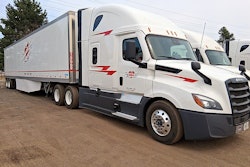A 25% tariff set to take effect next week on imported vehicles and certain vehicle components could add upwards of $30,000 to the cost of a new Class 8 truck, according to estimates from the American Trucking Associations, and that's not the only pressure looming for sales of new trucks.
The U.S. Environmental Protection Agency in March announced it will reconsider the Greenhouse Gas Phase 3 (GHG3) regulations for commercial vehicles. EPA also said it was reevaluating the 2022 heavy-duty Nitrogen Oxide (NOx) rule.
Those regulations, bundled with similar regulations implemented by the California Air Resources Board (CARB) – which, too, are under political re-evaluation – were supposed to spark a pre-buy of new heavy trucks ahead of the 2027 model year.
While the process of repealing or modifying these regulations is lengthy, if these regulations are rolled back or significantly eased, it could dampen the anticipated surge of orders of new trucks before 2027, which was expected to gain momentum later this year and accelerate into 2026.
EPA’s reconsideration of the regulations increases the likelihood of a more lenient approach or a complete rollback, said Dan Moyer, senior analyst of commercial vehicles at FTR Transportation Intelligence, thereby reducing the urgency for fleets to pre-buy, as concerns over future compliance costs diminish.
As a result, Moyer noted that FTR has removed projected pre-buy volumes from its baseline forecasts for Class 8 and Class 6-7 trucks and tractors. However, the figures are still tracked separately to help stakeholders assess potential impacts should stricter regulations remain in place.
Steve Tam, vice president, ACT Research, noted his firm has already seen slowing order intake the past couple of months, as "truckers [take] a wait-and-see approach as the appropriate agencies review their respective regulations."
In February, FTR’s data on North American Class 8 net orders saw a 31% decline from the previous month and a 38% decline year-over-year.
[RELATED: Tariff plans could disrupt truck production and pre-buying activity]
Chris Visser, director of specialty vehicles at J.D. Power, pointed out that new truck prices will still rise as manufacturers seek to recover investments in new engine emission technology, aftertreatment systems, and aerodynamics – and any potential added duties from tariffs.
“Engine technology is already production-ready, and manufacturers will want to recoup the development work,” he said.
However, Visser pointed out that the price increases may be more moderate if elements like extended emissions warranties and advanced aftertreatment systems are postponed or eliminated from existing regulations.
Order forecast
Tam said some fleets began pre-buying trucks as early as 2023 to get ahead of stricter emissions regulations expected in 2027. By the firm’s estimation, between 40,000-50,000 units were purchased in 2023 and 2024 as part of the early pre-buy activity.
“If the current regulations are completely eliminated, we forecast that North American Class 8 sales in 2025 and 2026 would average 15% lower for the two years,” Tam said.
Moyer noted that even though his firm is removing pre-buy volume from its Class 8 and Class 6-7 forecasts, "our baseline forecasts are still showing positive, year-over-year market growth in 2026 and 2027.”
Instead of a concentrated surge in orders ahead of new regulations, demand is expected to be distributed more evenly across subsequent years, Moyer said.
Regulatory rollback typically encourages fleets to revert to normal replacement cycles rather than make accelerated purchases, Moyer said. However, ongoing uncertainty around future regulatory changes and pricing could still lead some fleets to engage in precautionary pre-buying, though at a smaller scale than expected.
Market balancing
A decrease in new truck purchases could also have several downstream effects. Visser said that with a limited pre-buy, the number of truck trade-ins won’t spike dramatically, helping to keep supply relatively stable, meaning used truck prices won’t be heavily impacted by a flood of trades.
Tam also said that lower new truck sales and fewer trade-ins would help reduce the excess capacity that has strained the used truck market in recent years.
“Assuming freight volumes maintain or grow, used truck prices would increase. If freight also declines, then the change in used truck prices will depend on which falls faster: supply or demand,” Tam said.
The spot market will serve as a key gauge of the balance between available trucks and freight demand, he added.
As fleets consider their procurement plan, Moyer said motor carriers should evaluate economic conditions, potential tariff changes, regulatory uncertainty, shifts in vehicle pricing, and overall market demand.
Additionally, fleets should consider strategically timing purchases, account for vehicle availability, advancements in technology, and long-term operational costs.













